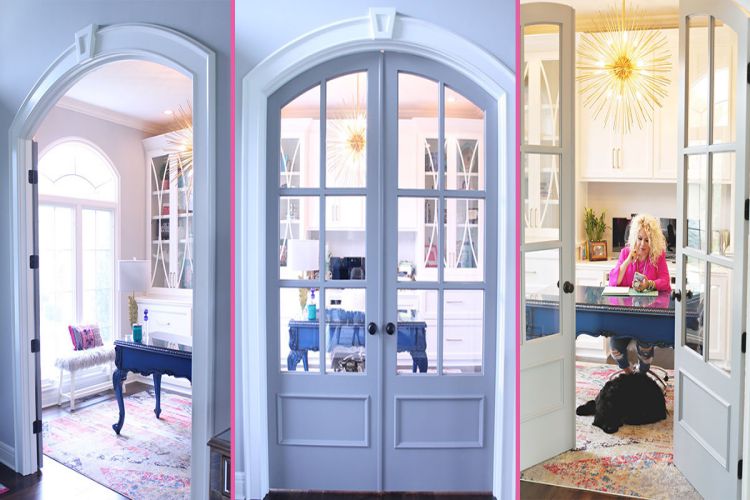Ever walk down a hallway in your own home and feel like you’ve entered a cave? You flick on a light, but the space still feels confined and dim. The surprising culprit might be hiding in plain sight: your doors.
We often think of doors as simple necessities for privacy and passage. However, they are one of the most underrated tools in home design for transforming the look and feel of your space. This article will guide you through the art of selecting interior doors that not only connect your rooms but actively draw in and amplify natural light, making your entire home feel brighter, bigger, and more welcoming.
Choosing the right door is about more than just function—it’s a design decision that can fundamentally alter a room’s ambiance, boost your mood, and even enhance your home’s perceived value, all without tearing down a single wall.
The Reflective Power of Color and Finish
The simplest way to turn a door into a light source is by treating its surface as a reflective plane. The color and sheen you choose can either absorb precious light or bounce it deeper into your rooms.
The Unbeatable Brilliance of White
It’s a classic for a reason. Pure white reflects the highest percentage of light, instantly making any space feel cleaner and more open. When planning your door installation, consider how the door rough opening dimensions will affect the overall light flow—a properly sized opening with a bright white door can maximize the light transfer between rooms.
Shades of Light:
- Crisp, True White: Offers a modern, gallery-like feel and maximum light reflection
- Off-White & Cream: Provide a softer, warmer glow that is less stark but still highly effective at brightening a space
Beyond White: Using Light-Boosting Hues
You don’t have to stick to white. Soft, pale colors can also work wonders. Think of light, airy pastels like powder blue, a faint buttery yellow, or a soft, misty grey. These colors have high Light Reflectance Values (LRV), meaning they bounce back more light than they absorb.
Pro Tip: For a seamless, expansive look, paint your doors the same color as your walls or trim. This continuity tricks the eye into seeing a larger, uninterrupted space.
The Secret Weapon: Surface Sheen
A door’s finish is just as important as its color. The sheen level you choose can dramatically impact how much light your door reflects back into the room.
Satin or Semi-Gloss: These sheens have a subtle luster that catches and reflects light around the room. They’re the perfect middle ground, offering durability and a noticeable brightening effect.
High-Gloss: Makes a bold, dramatic statement and offers the highest level of light reflection, almost like a mirror. Ideal for a modern, glam aesthetic.
Matte: While trendy, a matte finish absorbs light and should be used cautiously in areas you want to feel brighter.
Let the Light In: The Magic of Glazed Doors
If you want to dramatically improve the flow of light between rooms, incorporating glass is the most effective solution. This is a foundational concept in interior design—doors with glazing can solve the issue of a windowless room or dark corridor.
French Doors vs. Full-Lite Doors
French Doors: Featuring multiple panes of glass (lites), these doors offer a timeless, elegant look. They’re perfect for visually connecting a dining room to a living room or a bedroom to a sunroom, sharing light between the spaces while still providing a sense of separation.
When installing French doors, ensure your door rough opening is properly framed to accommodate both door panels and allow for smooth operation while maintaining structural integrity.
Full-Lite Doors: A single, large pane of glass provides a sleek, contemporary aesthetic. This style maximizes the amount of light passed through and is ideal for home offices or pantries where you want an unobstructed view and maximum brightness.
Privacy Without Sacrificing Brightness
Frosted Glass: This is the go-to option for bathrooms, bedrooms, and home offices. It obscures visibility completely while diffusing soft, even light, ensuring the space doesn’t feel like a dungeon.
Reeded or Fluted Glass: This Art Deco-inspired textured glass is a major trend. The vertical grooves distort the view for privacy but allow light to pass through, creating beautiful, shifting patterns throughout the day.
Clear Beveled Glass: The angled edges of beveled glass catch the light and refract it, creating a subtle rainbow effect that adds a touch of elegance and visual interest.
Strategic Styles That Create Space and Light
Sometimes, the style and function of a door itself can make a space feel more open and bright. Thoughtful interior design means considering doors as integral elements of a holistic and functional environment.
The Disappearing Act: Pocket and Barn Doors
Instead of swinging into a room and taking up valuable floor and wall space, these doors slide away. A pocket door disappears into the wall, while a barn door slides alongside it.
The Benefit: By eliminating the “door swing,” the room feels less cluttered and the pathway for light is wider and more uninterrupted, especially when the door is left open. When planning for these installations, your contractor will need to modify the standard door rough opening to accommodate the sliding mechanism and track system.
The Ultimate Reflector: Mirrored Doors
Placing a mirror on a door (typically a closet door) is one of the most powerful ways to enhance a small or dark room. It serves a dual function—not only does it work as a door, but it also bounces nearly 100% of the light that hits it, effectively doubling the light in the space.
The reflection creates a profound illusion of depth, making the room feel significantly larger. It’s like having a window that reflects your own space back at you, creating an endless loop of light and visual expansion.
The Most Open Option: The Cased Opening
In areas where a physical barrier isn’t truly necessary (like between a living room and dining area), consider forgoing a door altogether. A cased opening is simply a doorway that’s framed with beautiful trim and molding.
This approach creates a graceful transition between rooms and allows for the absolute maximum flow of light and air. It’s particularly effective in open-concept homes where you want to maintain some architectural definition between spaces without blocking light flow.
Practical Considerations for Maximum Impact
Think About Traffic Flow: Consider how often the door will be opened and closed. Frequently used doors should prioritize durability alongside light-reflecting properties.
Room Function Matters: A bathroom door requires different considerations than a home office door. Privacy needs, moisture resistance, and light requirements all play a role in your decision.
Consider Your Home’s Architecture: A Victorian home might benefit from traditional French doors with divided lites, while a modern home could shine with sleek, full-glass panels.
Budget Wisely: You don’t need to replace every door at once. Start with the doors that connect your darkest spaces to your brightest ones for maximum impact.
Conclusion
Brightening your home can be as simple as choosing a high-sheen paint color, as transformative as installing elegant French doors, or as clever as using a space-saving barn door. The key is to consider a door’s material, transparency, and style as active design elements rather than afterthoughts.
A door is never just a door—it’s a dynamic feature that can define the character of a room. By choosing with light in mind, you’re not just closing off a space; you’re opening up your home to a brighter, more beautiful, and expansive way of living. Every time you walk through one of these thoughtfully chosen doors, you’ll be reminded that the best home improvements often come from reimagining the elements we see every day.

